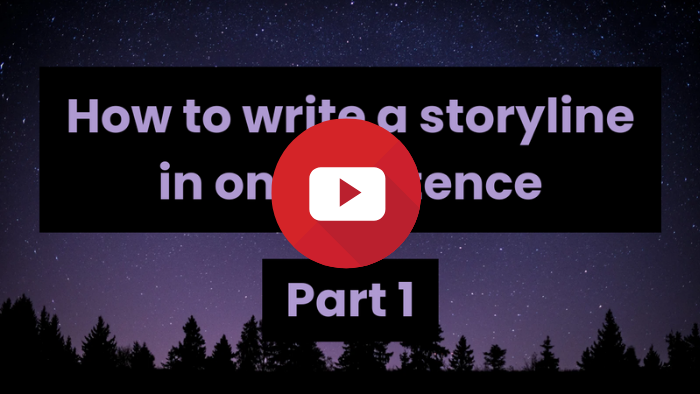Learning how to write a storyline in one sentence is a useful skill, and it’s necessary for creating your dream story. It acts as a road map and determines what the narrative will be about. Brainstorming plotlines can also be fun to do once you’ve gotten the hang of it.
Let me start off by explaining what a storyline is. If you look up the word storyline on Google, it’s described as the plot of a novel, play, movie, or other narrative form.
Although that definition is correct, I have my own version of what a storyline is. To me, a storyline is what the story is about in one sentence.
What I just mentioned is my opinion that I formed after years of writing. Some people told me it’s crazy to describe a tale in a single sentence. I understand why they said that. To a degree.
What these people are really saying is: How is it even possible to tell what a story is about in one statement? They believe you need multiple sentences or pages in order to portray a plot.
From my personal experience, whenever I’ve written storylines, I was able to recognize the true meaning of whatever I am scripting. A one-sentence storyline is essentially a shortened guide of the story’s plot.
I divided my storyline creating process into 3 steps:
- Write your ideas down
- Identify the most important elements
- Write your storyline in one sentence
My methods require some work to do just to write a single sentence. However, it is worth following along. By the end of this post, you will learn how to write a storyline in one sentence and advance further in your writing adventure.


1. Write your ideas down
So my first step of creating a one-sentence storyline is to write your ideas down. You can get some paper and a pen, or you can type them on a computer. I prefer paper, but you do you boo.
We are all born with imagination. There are so many thoughts running through our heads everyday. Maybe you’ve been in class or at your job, and you found yourself daydreaming about a cool story you’ve thought about writing someday.
As for me, I think about my dreams everyday. I don’t only like telling stories. I think about ways to take care of my family, fun things I want to do with my friends, places I want to travel to, and how I can just enjoy my life overall.
I bring this up because it’s easier to write from your real-life experiences. You can incorporate the love for your dreams and goals in the stories you want to build.
With that being said, even if you have a notion of what you want to create, it will not come to life unless you write your ideas down.
I met people who told me they want to create stories, but their ideas remain in their heads. People have different reasons as to why they don’t want to record their thoughts. They do not take writing seriously. They do not think they’re good enough. Or they think they have dumb ideas. These are a few common reasons why people never start.
I am aware of these beliefs because people admitted them to me in past conversations. They said something along the lines of: “Oh you like to write books? That’s amazing! I would love to write a book too, but it’ll never happen. It’s all in my head.”
It’s kind of depressing for me to even mention these past interactions. Then again, not everyone wants to be a writer. Or if they do want to be one, they don’t take it seriously enough to make it into a career.
One thing I realized is that dumb ideas can turn out to be bestsellers. Dumb ideas, or any idea, are subjective. One person may like something and another person may not like it.
A book I read when I was younger was Diary of a Wimpy Kid. I thought the concept was dumb at the time, but I still enjoyed it a lot. That is my opinion.
Diary of a Wimpy Kid is about a 12 year old kid named Greg Heffley and his adventures through the dreaded middle school. His dorky best friend Rowley is always there to support him. Greg has an older brother called Rodrick who is a jerk to him. As well as his younger brother Manny who is also a jerk but pretends to be innocent in front of their parents.
The story is cringey in its own ways; however, it’s well-written and has interesting drawings in the books. I recommend you check it out.
You can also tell your kid or younger sibling to read the books and give you a review.
What’s nice is that the Diary of a Wimpy Kid book series is ongoing and still being published to this day. There are also 3 movies which are hilarious and heartwarming.
Before anyone comments, yes I know there are 4 movies. I pretend the fourth one doesn’t exist since the original cast isn’t there. Although I might eventually watch the movie anyway just to see what it’s about.
Anyway, I try to read different types of books because it often gives me inspiration for my future stories. As I was saying earlier, write your ideas down. It doesn’t matter how random they are. Or if they make sense at the moment.
Focus on generating as many ideas as you can. Not everything you’ve come up with will make it through the first round. And that’s okay.
If you are having trouble thinking of ideas for your story, a good tip which has worked for me is to take a walk outside. This is one thing I do whenever I feel burned out, and my mind isn’t functioning properly.
It is crucial to take breaks every once in a while so that your brain can unwind. When you return to your journal or computer to brainstorm, it will be a lot easier to get the process going again.
Here is an example I created in order to show you guys what the first step looks like.
This is a series of ideas I talked about in my How to write a storyline in one sentence video (Part 1):
- Let’s say we have a character named Ray who feels like he’s invisible.
- When I think of this character, at first, I describe him as withdrawn, quiet, and naturally shy.
- He meets a friend who appreciates him for who he is.
- She is the first to be his friend and is kind to Ray.
- Ray still bottles up his feelings and keeps his thoughts to himself.
- Through his new friend, he discovers the art of tea.
- He loves brewing it and creating new flavors.
- His newfound love of tea changed his life, and Ray decides to become a master tea maker.
- His passion also helped him become more confident and he uses tea to connect with others.
Writing your ideas down simply transfers your thoughts onto paper so that you are able to understand the story to a deeper extent. It also prepares you for the second step in our one-sentence storyline process.

2. Identify the most important elements
After you’ve written down your ideas, the next thing to do is to identify the most important elements. These crucial details are the key to creating your one-sentence storyline.
Before I delve into this any further, I have a couple of blog posts which can help you become a better writer. Whether you are a beginner or you’re more experienced in this field, anyone can benefit from reviewing the basics every once in a while.
Click on the buttons below if you would like to learn more:
Now let’s move on to some of the most important elements.
They consist of:
- Characters
- Setting
- Conflict
- Resolution or Conclusion
If you followed my first step and wrote your ideas down, you might have listed some, if not all of these elements.
If you are missing elements, that’s okay. I will list questions to help you fill in the gaps if you’re missing anything.
- Who are the characters? Who is the main character? Who is the antagonist?
- What is the conflict? Or what is the main problem in the story?
- What do you want the main character to accomplish? Or what is the main character’s goal?
- Where does the story take place?
- Does the conflict get resolved? How does the story end?
If you can answer these questions, you should have more than enough information to create your storyline.
Each storyline is going to be different. However, it usually involves a character and the overall action or change that takes place in the book.
In some books, authors have written about organizations as a whole or focused on multiple characters as the stars of their stories.
My example for this post only focuses on a singular character: Ray. Even with a story featuring multiple characters or a group of people, you can still make a one-sentence storyline about them.
I’ve written a storyline for one book that I’ve worked on, and it highlights two individuals as my main characters. The characters are connected to the plot of the story and feed into each other’s interactions equally. It would make sense to include both characters as part of the same storyline, rather than separating them.
Back to my particular example of Ray and his journey, these are the most important elements that I identified:
- Who Ray is as a person
- His inner struggle
- The catalyst that caused him to open up to people more – which is tea
- The results of his development – which is Ray becoming more confident and being passionate about tea.
I will also use the set of questions I showed before to further identify more elements.
Who are the characters? Who is the main character? Who is the antagonist?
- Ray is the main character. His new friend who helps him get into tea is a supporting character. While there isn’t an antagonist, Ray struggles with being socially withdrawn and passive in life.
What is the conflict? Or what is the main problem in the story?
- Ray feels like he’s invisible and lonely in his personal life.
What do you want the main character to accomplish? Or what is the main character’s goal?
- In the story, I want Ray to step out of his shell and experience friendship. I want him to create new meaning in his life, so he won’t wander aimlessly without a purpose.
Where does the story take place?
- The story primarily takes place in a tea shop that Ray starts to work at.
Does the conflict get resolved? How does the story end?
- Yes, the conflict eventually gets resolved. At the end of the story, Ray becomes more confident and learns to appreciate the beauty of life. He finds out that connecting with new people can be an enriching experience, and he tries to make people smile by sharing his love of tea with the world.
Make sure to take your time during this step of the process. If you feel like it’s difficult to identify the most important elements, you can go back to the first step and write more ideas down to clearly define your story.
Getting a second opinion from someone else brings a new perspective to the table. They might be able to understand your writing in a different light and can help you organize your thoughts.
Here are some good questions to ask another person when you present your ideas:
- What do you think is happening in the story?
- Can you tell me what you think is happening in this list?
- What do you think are the most important details? Why?
I don’t think there is necessarily a right or wrong answer. When you ask someone else for their opinion, keep in mind that this is how they see things in life. That person may be able to point out a different direction you can implement in your story. Or they might mention your plot isn’t that great overall, and it needs to be improved even further.
It’s important to listen to what others have to say and discern which feedback is actually beneficial. If you want to learn how to write a storyline in one sentence, it helps to be open-minded and considerate of other people’s perspectives.

3. Write your storyline in one sentence
As for my final step in the storyline-creating process, all you have to do now is use all of the information you just gathered and literally write your storyline in one sentence. Just do it!
Look at your ideas from step one. Adjust the details in step two if necessary. And describe the direction your story is going in.
Here is the final storyline from my story:
- Ray, a naturally shy and nearly mute man, uses his newfound passion of crafting tea to connect with others.
I will also give you guys examples of storylines from movies and books.
Mulan
The first one is Mulan. Yes, everyone knows this movie. But can you see what the storyline is?
The storyline is:
- Mulan, a young woman, dresses up as a male soldier so that she can take her father’s place in the war against the Huns and save China.
I will now explain the connection between the storyline and the entire plot. If you have never seen Mulan and don’t want any spoilers, you can scroll down until you see the words “End of spoiler”.
Start of spoiler
This plot already defines the movie from beginning to end. It’s clear who the main character is, and that’s Mulan. The setting is in China since it clearly mentions the country.
The main conflict is her fight against the Huns, as well as family and societal tensions. I don’t know much about Chinese history, but I have heard of the phrase: “Women are to be seen, not to be heard.”
In the beginning of the movie Mulan, Mulan is given a makeover by the matchmaker of their village. Women are raised to be feminine and quiet people so that they can marry a man and live to be their wife. This is common in many cultures in real life. So I’m not surprised if they had this in China too.
Since women are expected to only be wives and mothers, it’s a given that they’re not allowed to enlist in the military.
In the movie, Mulan’s father is drafted into the military again as an order by the Chinese emperor. The sad thing is that her father was injured from his last military service. He is also getting old and cannot move as well as he used to.
Mulan doesn’t want to risk losing her father, so she cuts her hair, steals her father’s armor, and goes to the military camp herself. Disguised as a man, of course.
With Mulan making this decision to go to war, she challenges societal expectations of what a woman should not be. She chooses to make her own path. And she does this to protect her family and the country she loves.
Continuing from the storyline, it also lists the resolution of the movie: Mulan saves China.
End of spoiler
Your storyline does not need to list every element. It just needs to be enough to express what the story is truly about.
Aladdin
The second additional storyline is from Aladdin. If you can tell by now, I obviously love Disney. I also chose to mention Aladdin because I watched it at a cafe while working on this blog post.
The storyline is:
- Aladdin, a poor man from Agrabah, wishes upon a magic lamp to become a prince so that he can be with Princess Jasmine, as well as saving Agrabah from the villainous Jafar.
The Remarried Empress
As for my third storyline, this one is not a movie. It’s a comic called The Remarried Empress, which is one of my favorite romance stories. You can read it on Webtoons.
This storyline is:
- Although Navier is the perfect empress of the Eastern Empire, she goes through a painful divorce and ends up marrying the king of the Western Kingdom, thus retaining her status as a monarch.
After reading this blog post, I hope you gained some understanding and inspiration in your writing journey. Don’t forget that with patience, commitment, and these tips in mind, you can definitely write an amazing storyline!
Thank you for reading How to write a storyline in one sentence! I hope you enjoyed it! 💜
Comment down below if you have any storylines that you would like to share. You can even ask me any questions you have about storytelling in general.
I participated in an exercise before where we had to share storylines with the rest of the group, and some of the ones I’ve heard were hilarious. So I’m curious as to what kind of cool ideas you guys come up with.
If you are interested in joining the Nikkaflora fam for this journey, scroll down this page, sign up for my weekly newsletter, and follow me on my social media.
You’ll stay updated on what’s new, receive more personal growth and creativity content, and we’ll have even more fun. See you there!
Until then, let’s create, appreciate, and f*** that hate!

